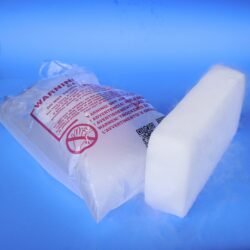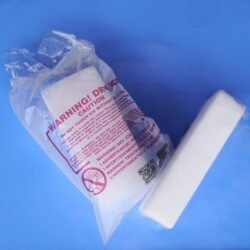Unveiling the Truth – Dry Ice Edition!
Dry ice, with its mesmerizing fog and exceptional cooling properties, is a unique substance often surrounded by misconceptions and myths. Here we are, to debunk some of the common myths associated with dry ice.
Let’s separate fact from fiction and explore the truth behind the haze.
Dry Ice melts like regular Ice!
Contrary to popular belief, dry ice does not melt in the same way as regular ice. Traditional ice yields water upon melting while Dry ice converts into gas, undergoing a process called sublimation.
The reason behind this is Dry ice is a solid form of CO2, converted into white blocks of different shapes and sizes at very low surface temperatures.
This unique characteristic makes dry ice an ideal choice for certain applications where a residue-free cooling solution is essential.
Dry ice can be consumed!

Has this question ever popped up in your mind: Can you eat dry ice?
It’s a question that has lingered in the air for quite some time, surrounded by myths and misconceptions. Let’s clear the air and dispel any illusions:
DRY ICE CANNOT BE EATEN!
It’s essential to emphasize that consuming dry ice is not only unsafe but can pose significant health risks. Yes, you read it correctly – eating dry ice is a practice best avoided at all costs.
So, what happens if you eat dry ice? When dry ice enters your mouth, it can cause instant frostbite, due to its extremely low temperature (-78.5 degree Celsius or -109.5-degree Fahrenheit) harming your tongue, gums, and throat. In the event of swallowing, the repercussions escalate, potentially causing severe internal burns and giving rise to critical complications like gastric perforation or asphyxiation.
Dry Ice Can Only Be Used for Cooling and Preserving Purposes
While dry ice is renowned for its exceptional cooling properties, its uses extend far beyond refrigeration. From creating captivating special effects in the entertainment industry to being a powerful cleaning agent (Dry Ice Blasting), this versatile substance has applications in various industries. Its ability to sublimate without leaving behind residue makes it an eco-friendly and effective solution in many scenarios.
Inhaling Dry Ice is not harmful
Storing dry ice in inadequately ventilated spaces can potentially expose individuals to elevated levels of carbon dioxide (CO2), replacing essential oxygen in the body. This may result in adverse effects, ranging from headaches and confusion to disorientation, and in extreme cases, it can even be fatal. It emphasizes the importance of ensuring proper ventilation when handling and storing dry ice to mitigate any potential risks to health and safety.
As a general rule, dry ice should be stored and transported only in appropriate, well-insulated containers. These containers must not be airtight (danger of explosion). In enclosed spaces and vehicles, adequate ventilation must always be ensured during transportation, storage and use.
Can Dry Ice Be Used as an Air Conditioner?
The idea of using dry ice as an air conditioner might sound innovative, but it’s more myth than reality when it comes to practical applications. While dry ice does produce a cooling effect as it sublimates—changing directly from a solid to a gas—there are several reasons why using it as an air conditioning solution is not recommended. First, dry ice releases carbon dioxide as it sublimates, which can accumulate and pose health risks in poorly ventilated areas. High concentrations of CO2 can lead to dizziness, headaches, or even more severe health issues.
Secondly, the cooling effect from dry ice is temporary and not scalable for maintaining consistent temperatures over extended periods, unlike conventional air conditioning systems designed for sustained cooling. Additionally, the cost of continually purchasing and replacing dry ice to maintain a cool environment would quickly become impractical. For these reasons, while dry ice is effective for specialized cooling purposes—like in dry ice coolers or fog production—it falls short as a reliable or safe substitute for traditional air conditioners.
To make Dry Ice last longer, keep it in a freezer
When it comes to storing dry ice, many people wonder if they can put it in their freezer. Although it might seem logical to use your freezer to keep dry ice solid for longer periods, it’s generally not recommended. Dry ice is much colder than the temperature your freezer is designed to maintain, which is around 0°F (-18°C). Dry ice, on the other hand, sits at a frigid -109.3°F (-78.5°C). When you place dry ice in a freezer, it can trick the thermostat into reading a colder temperature than it actually is, leading the freezer’s compressor to shut off prematurely. This could cause your other food items to thaw, as the freezer stops cooling properly. Additionally, placing dry ice in the freezer can cause mechanical damage over time due to the extreme cold, potentially shortening the life of your appliance.
Moreover, storing dry ice in a freezer poses safety concerns beyond just damaging the appliance. As dry ice sublimates, it turns from solid to carbon dioxide gas. In a confined space like a freezer, this gas can build up, especially if the freezer is airtight. This can lead to pressure buildup that might cause the freezer door to pop open, or in extreme cases, could potentially damage the freezer itself. Additionally, carbon dioxide can displace oxygen in enclosed spaces, creating a suffocation hazard, particularly if the freezer is opened in a poorly ventilated area.
If you’re wondering how long dry ice will last in a freezer, the answer depends on various factors like the size of the dry ice block and how often the freezer is opened. Typically, dry ice may last between 18 to 24 hours, but this can vary widely. Instead of placing dry ice in the freezer, it’s better to store it in a high-quality cooler specifically designed for dry ice. These coolers provide the right insulation to slow down the sublimation process without posing a risk to your appliances or creating safety hazards in your home.
You can touch Dry ice with bare hands
Given its surface temperature of approximately −109.3 degrees Fahrenheit, handling dry ice directly with bare hands is not a good idea.
Immediate consequences can include burns, damage, or the frostbite on your skin within mere seconds.
For safe interaction with dry ice, it’s important to consider protective measures. Always opt for tongs or protective gloves to handle Dry ice. Vigilance and protective gear are paramount when dealing with this extremely cold substance.
Can You Freeze Dry Ice?
Dry ice, composed of solid carbon dioxide, is already in a frozen state at standard atmospheric pressure and temperatures. Therefore, the concept of “freezing” dry ice is somewhat misleading. Unlike regular ice made from water, which can be frozen or melted, dry ice remains solid at temperatures below -78.5°C (-109.3°F). Attempting to freeze dry ice would not alter its state; it would simply remain solid carbon dioxide until it sublimates into gas.
Because of its unique properties, dry ice serves as an effective cooling agent, utilized in various applications, from preserving perishables during transportation to creating special effects in theatrical productions.
While you cannot freeze dry ice further, it’s important to understand how to handle it properly to maximize its effectiveness. Dry ice sublimates, meaning it transitions from a solid to a gas without becoming liquid, which is why it’s crucial to store it correctly.
Using insulated containers and ensuring proper ventilation helps slow the sublimation process, extending the useful life of dry ice. Additionally, dry ice should be kept away from direct sunlight and heat sources, as these factors can accelerate sublimation. By managing these conditions, you can effectively utilize dry ice for various cooling needs without the misconception of needing to freeze it.
Dry Ice Mosquito Trap
dry ice mosquito trap effectively attracts mosquitoes by utilizing the carbon dioxide (CO2) emitted as dry ice sublimates. This method mimics the scent of a potential host’s breath, drawing mosquitoes closer to the trap. These traps often include features that optimize CO2 dispersal and may use light to enhance attraction. To maximize effectiveness, it’s best to position the traps in shaded areas, away from competing light sources.
Using dry ice mosquito traps is beneficial for both residential pest control and scientific research. They help in capturing mosquitoes while providing valuable data on mosquito behavior and population monitoring. With the right setup, these traps can remain effective for several hours, making them a practical solution for mosquito control.
Dry Ice Cooling: An Effective Temperature Management Solution
Dry ice cooling is an exceptionally efficient method for maintaining low temperatures in various applications, thanks to its unique properties. With a surface temperature around -78.5°C (-109.3°F), dry ice is invaluable in industries such as food and pharmaceuticals, where precise temperature control is critical. For instance, it is commonly used to keep perishable items like ice cream and frozen foods solid during transport, ensuring their safety and quality upon arrival. Additionally, dry ice is crucial in the medical field for transporting temperature-sensitive vaccines and medications, preserving their effectiveness throughout the shipping process.
However, the use of dry ice cooling requires careful handling to ensure safety. As dry ice sublimates, it transforms into carbon dioxide gas, which can lead to pressure buildup in confined spaces if not properly managed. Therefore, it is important to store dry ice in well-ventilated areas and to avoid airtight containers. When handling dry ice, using protective gloves is essential to prevent frostbite or cold burns. By following these precautions, users can effectively utilize the benefits of dry ice cooling while minimizing potential risks associated with its use.
Dry Ice can be disposed of in the trash
For one, it’s not advisable to discard Dry ice casually in the drain due to the potential harm it may cause to your sink and plumbing. There’s even a risk of a burst pipe if the dry ice becomes lodged in a high-pressure point.
For safe disposal of dry ice, opt for an open, well-ventilated area, far from the reach of pets or children. To maintain safety, it’s recommended to keep the dry ice in its original packaging, placing it on a towel. This method allows the dry ice to sublimate harmlessly in a short period, ensuring a hassle-free and secure disposal process.
What Happens If You Touch Dry Ice?
Touching dry ice can be a painful and potentially dangerous experience. Dry ice is extremely cold, with a temperature of -109.3°F (-78.5°C). When you touch it with bare skin, the extreme cold can cause a type of burn known as frostbite. This happens because the skin cells freeze and get damaged, much like how your skin would react to touching a very hot surface. The coldness can numb the area quickly, which might make you unaware of the damage being done. Even a brief contact can cause red, blistered skin that feels similar to a burn from heat. Prolonged contact can cause more severe frostbite, leading to deeper skin damage and the potential for long-term effects. Always use insulated gloves or tools when handling dry ice to avoid direct contact and keep yourself safe.
As we’ve debunked these common myths, it’s evident that dry ice is a fascinating and versatile substance with properties that set it apart from conventional ice. Understanding the facts about dry ice empowers individuals and businesses to harness its benefits safely and effectively. Whether you’re looking to create a spooky fog effect or need a reliable cooling solution, knowing the truth about dry ice opens up a world of possibilities. Embrace the science, dispel the myths, and let dry ice work its magic in a variety of applications.





